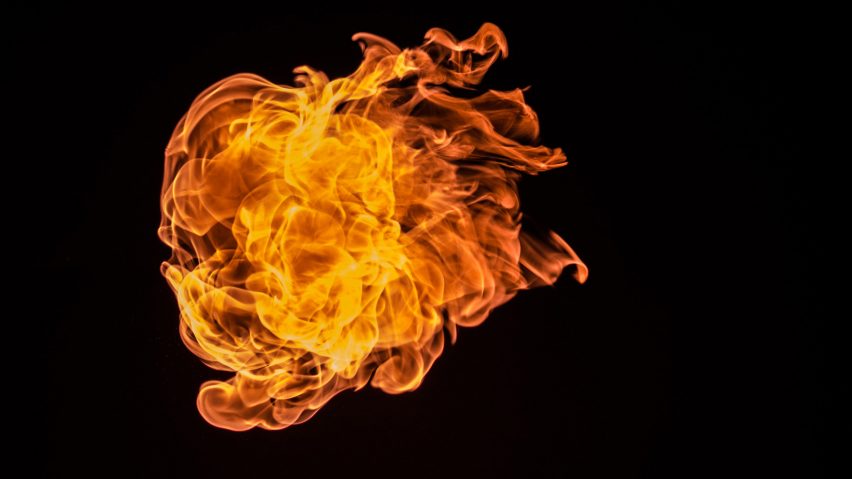
US scientists develop "nanoscale" coating to combat spread of fires
A team of scientists from universities in the United States have developed a silicon-based coating that can help stop the spread of fires by preventing materials coming in contact with flame.
The coating was developed to slow the spread of fire by limiting the amount of combustion that happens on a molecular level as fires start to spread.
"The problem with fire is it is complex, it's difficult to understand," professor of materials science and engineering at North Carolina State University Martin Thuo told Dezeen.
"Fire is like a three-legged stool. You need oxygen, fuel and heat. But all these are resting on a set of pretty complex chemistry, there's a set of reactions that have to take place for the fire to propagate and for the fire to continue burning."
Material forms a barrier where exposed to fire
By using a chemical process and working at the molecular level, Thuo and his team have found an application for a material he originally helped develop at Iowa State a decade ago. The findings were published in a recent academic paper that details the molecular makeup of the material.
The silene material is carbon-based and can be applied to the surface of materials like wood. It rests on top of the natural layer of water molecules that occurs, creating a barrier between combustible molecules and the flame.
"The oxygen cannot go through this material," he told Dezeen. "And the transfer of the heat is also not that efficient."
The coating itself is almost undetectable and can be applied using an oil-like solvent in a spray or applied as a fume in a chamber. It has also had success in keeping out water and bugs.
After being applied, the coated material can be applied to intense flames. The outer layer of the coating combusts but the inner layer reacts to flame, essentially creating a layer of glass that limits the amount of oxygen.
Where other fireproofing techniques involve using paints that release chemicals to suppress the fire or thick cement-like coating, this nanocoating uses small chemical reactions that do "not have toxic emissions on burning", according to Thuo.
Thuo added that the material is not meant to make buildings completely fireproof – only to slow the flame and give inhabitants and firefighters more time.
Scientist hopes it can be applied to temporary structures
He told Dezeen that his work at applying the material has been aimed towards "semi-permanent structures", specifically the market stalls in Kenya, and he believes that materials like cardboard, which are durable but do not hold up in flames or in wet conditions, could benefit from the coating.
"Cardboard and paper is very, very strong," Thuo told Dezeen.
"But once it rains, it's gone. If there is a fire, it's gone. If you put it in the ground, like in a place like Africa or in the tropics, the bugs will chew it. But could we use a nanoscale coating to completely transform these materials to something else?"
"If you could find time, people can recover their goods, and if you have your cardboard-based houses, it's easy for you to even collapse them and go if you see a fire starting in the neighbour's house So that ability to buy time becomes critical for those people."
Thuo has been working with architects and other scientists at Jomo Kenyatta University, and the team plans to build entire structures to test how the coating would function in a "disaster".
Kenyan architect Dennis Karanja told Dezeen that Thuo's work offers a platform for "affordable applications" for material technologies that he hopes "will be mainstreamed in the next few years".
According to Thuo, the Kenyan government has shown interest in the project and he has been looking for private-sector partners to help bring the material to scale. The team has not yet finalized cost estimates, but he said "we expect this to be a fairly affordable product given that it takes so little to coat a large volume of cardboard".
It could be used to prevent wildfire destruction
Thuo also believes that the coating could be used in ways that would help in the fight against wildfires. According to the National Interagency Fire Center, 39,044 wildfires have burned 1,972,850 acres in the United States alone in 2023.
He told Dezeen that one solution could be to erect perimeter walls coated in the nanomaterial around settlements to keep the fire out and to give firefighters more time.
Other design technologies that have been developed to address fire include a "spore cannon" designed by American Suzie McMurtry that would release mycelium during a fire to detoxify the soil.
In terms of prevention, researchers at Aalto University have developed an AI model that can be used to help predict the movement of wildfires.
The photo is via Pexels.
Project credits:
Research team: Stephanie Oyola, Chuanshen Du, Paul Gregory, and Dhanush Jamadgni